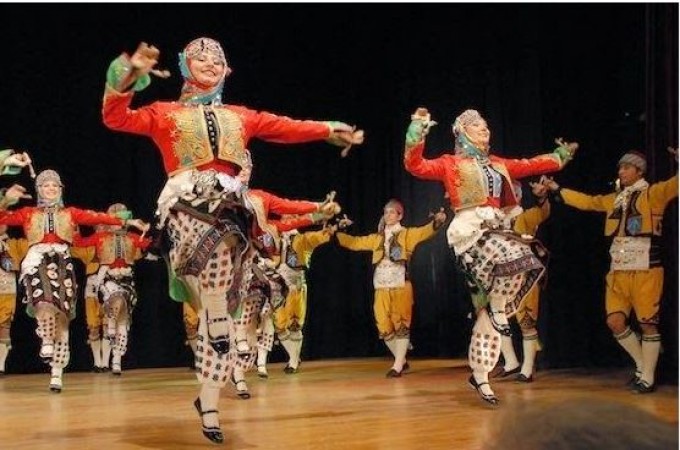
France is the country of the Enlightenment, is not internationally recognized just by Eiffel Tower but by its culture and folk dances. French people are very passionate about their culture and art, and several different French folk dances are famous worldwide. As folk dances reflect the culture and life of a particular region or country, many folk dances in France depend on distinct regions of France.
Also Read: The Dancing Plague of 1518: When Hundreds of People Couldn't Stop Dancing
Few Folk dance of France are:
Farandole
It is traditional folk dance that originates in the region of Provence, France. It is a lively and joyous circle dance often performed during festivals, weddings, and other community celebrations. The dance has a rich history dating back several centuries and is still cherished and performed in some region of France today. The dance is typically performed in closed circle or a long line. Dancers hold hands or link arms as they move together in a procession. The Farandole is usually accompanied by lively and upbeat traditional folk music. The music is an essential aspect of the dance, setting the tempo and mood for the participants. The Farandole is not only the dance but also symbol of community unity celebration. It brings people together, fostering a sense of togetherness and enjoyment. While it is popularity may have waned in some areas over the years, efforts to preserve and revitalize this traditional folk dance are ongoing, and it remains an important part of French heritage.
Also Read: Lyon, France: A Gastronomic Journey
Gavotte
It is a popular folk dance that originates in the 16th century in the French provinces of Brittany and Gascony which later became the part of European court dance during the baroque period and remained popular well into 18th century. The dance is characterized by its lively and graceful movements. Gavotte music is often written in binary form, consisting of two district section each usually repeated. The tempo is moderate, and the music is often characterized by its upbeat and spirited nature. The dance itself involves elegant steps and patterns, with dancers often bowing and curtsying to each other during certain parts of the choreography. The dancers often hold their hands in a particular position, which adds to the overall charm of the performance. The Gavotte dance has evolved over time and has been adapted to various regional styles. It has also influenced other dances and musical compositions throughout history. The Gavotte remains an essential part of traditional folk dance events; it is also occasionally performed in historical reenactments and as part of classical music performances and ballets.
Also Read: Musée d'Orsay: A Cultural Gem
Passepied
It is a lively and graceful folk dance that originated in France during the 17th century. It was a popular dance in the Baroque era and was commonly included in suites of dance movements within larger musical compositions. The dance is characterized by its distinct rhythm, often featuring a quick, short-long-short pattern or variations of it. Dancers traditionally perform the Passepied with intricate and intricate footwork, involving small and quick steps, jumps, and turns. The Passepied is often structured in binary form (A-B), with each section repeated. The dance incorporates elegant and flowing movements, with a certain lightness and buoyancy. The Passepied was commonly used as one of the standard movements in the Baroque dance suites, along with other dances like the Allemande, Courante, and Sarabande. Composers such as Johann Sebastian Bach, George Frideric Handel, and Jean-Philippe Rameau included Passepieds in their works. It also found popularity in other European countries and was adapted to local dance traditions in different regions. The Passepied evolved and transformed, but its historical roots as a lively folk dance remained an essential aspect of its character.
Also Read: Saint-Germain-des-Prés: Historic Place of France
Minuet
It is a graceful and elegant folk dance that originated in France during the 17th century. It is characterized by its moderate tempo and three-beat rhythm. The dance was popular among European nobility and became an essential part of formal ballroom events during the Baroque and Classical eras. The minuet is traditionally performed by couples in a ballroom setting. Dancers move in a series of small steps and graceful turns, often forming intricate patterns on the dance floor. The dance is known for its refined and courtly movements, making it a favorite among the aristocracy. In its musical form, the minuet is typically written with a clear emphasis on the first beat of each measure. Musicians often played minuets on the harpsichord, piano, or other classical instruments, and composers like Johann Sebastian Bach, Wolfgang Amadeus Mozart, and Ludwig van Beethoven incorporated the minuet into their compositions. The minuet evolved and influenced other dance forms, such as the waltz, which became more popular during the 19th century. While the minuet is not commonly performed in its original folk dance form today, its influence on dance and music history remains significant, and it is still appreciated as a representation of the grace and refinement of past eras.
Also Read: Iconic Louvre Museum Unveils Spectacular New Wing Showcasing Ancient Treasure